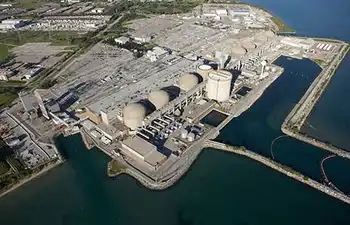US Government Provides Money For Coal Projects
WASHINGTON -- - The Department of Energy (DoE) chose the first eight projects to participate in the Clean Coal Power Initiative and expects to contribute $316 million of their $1.3 billion total cost.
Three projects are aimed at reducing power plant emissions in accordance with President George W. Bush's Clear Skies Initiative: The City of Colorado Springs, Colo., and Foster Wheeler Power Group Inc. will receive $30 million toward a $301 million project to build a 150-megawatt (mw) circulating fluidized bed combustor at the Ray D. Nixon power plant south of the city, which is expected to reduce sulfur emissions by up to 98% and mercury pollution by more than 90%; LG&E Energy Corp. of Louisville, Ky., plans to use $31 million of DoE funds in a $121 million project to build an advanced air pollution control system at the 524 mw Ghent Generating Station on the Ohio River east of Carrollton, Ky., with the goal of removing 99.5% of the plant's SO 2 output, 90% of its NO x emissions, and 90% of the mercury in the coal, while turning the byproducts into fertilizer; and Wisconsin Electric Power Co. of Milwaukee plans to use a $25 million DoE grant in a $50 million project to build a high-tech mercury and air toxic removal unit called Toxecon at the Presque Isle Power Plant in Marquette, Mich. Three other projects are intended to reduce greenhouse gases: Great River Energy of Underwood, N.D., and the Electric Power Research Institute plan to use $11 million of DoE funds in a $22 million project at the Coal Creek Station in Underwood to remove moisture from the plant's lignite fuel by using waste heat; NeuCo. Inc. of Boston will use $8 million of DoE grant money in a $19 million demonstration project at Dynergy Midwest Generation's Baldwin Energy Complex in Baldwin, Ill., to apply advanced computers using "fuzzy logic" techniques and improve performance of the plant's combustor, soot removal system, and emission controls; and University of Kentucky Research Foundation of Lexington and LG&E Energy will build a second project at the Ghent station using $4 million of DoE funds in a $9 million effort to separate unburned carbon from power plant ash and recycle it for fuel to produce a high-strength portland cement substitute called "pozzolan." Two additional projects are aimed at reducing air pollution via advanced gasification and combustion systems to extract energy from waste coal piles in Pennsylvania and West Virginia: Waste Management and Processors Inc. of Gilberton, Pa., will receive $100 million for a $612 million project to build and operate a power plant to produce electricity, industrial heat, and nearly 5,000 barrels per day of diesel fuel from raw anthracite wastes at a 75-acre site next to the existing Gilberton Power Plant; and Western Greenbrier Co-Generation LLC, a newly formed public service entity serving three West Virginia towns, will team with several firms to build a 75-mw circulating fluidized bed combustor fueled by a 4 million-ton coal waste pile at Anjean, W. Va., which also will produce steam for industrial use and district heating while converting waste ash and green wood waste into structural bricks.
The City of Colorado Springs, Colo., and Foster Wheeler Power Group Inc. will receive $30 million toward a $301 million project to build a 150-megawatt (mw) circulating fluidized bed combustor at the Ray D. Nixon power plant south of the city, which is expected to reduce sulfur emissions by up to 98% and mercury pollution by more than 90%;
LG&E Energy Corp. of Louisville, Ky., plans to use $31 million of DoE funds in a $121 million project to build an advanced air pollution control system at the 524 mw Ghent Generating Station on the Ohio River east of Carrollton, Ky., with the goal of removing 99.5% of the plant's SO 2 output, 90% of its NO x emissions, and 90% of the mercury in the coal, while turning the byproducts into fertilizer; and
Wisconsin Electric Power Co. of Milwaukee plans to use a $25 million DoE grant in a $50 million project to build a high-tech mercury and air toxic removal unit called Toxecon at the Presque Isle Power Plant in Marquette, Mich.
Three other projects are intended to reduce greenhouse gases:
Great River Energy of Underwood, N.D., and the Electric Power Research Institute plan to use $11 million of DoE funds in a $22 million project at the Coal Creek Station in Underwood to remove moisture from the plant's lignite fuel by using waste heat;
NeuCo. Inc. of Boston will use $8 million of DoE grant money in a $19 million demonstration project at Dynergy Midwest Generation's Baldwin Energy Complex in Baldwin, Ill., to apply advanced computers using "fuzzy logic" techniques and improve performance of the plant's combustor, soot removal system, and emission controls; and
University of Kentucky Research Foundation of Lexington and LG&E Energy will build a second project at the Ghent station using $4 million of DoE funds in a $9 million effort to separate unburned carbon from power plant ash and recycle it for fuel to produce a high-strength portland cement substitute called "pozzolan."
Two additional projects are aimed at reducing air pollution via advanced gasification and combustion systems to extract energy from waste coal piles in Pennsylvania and West Virginia:
Waste Management and Processors Inc. of Gilberton, Pa., will receive $100 million for a $612 million project to build and operate a power plant to produce electricity, industrial heat, and nearly 5,000 barrels per day of diesel fuel from raw anthracite wastes at a 75-acre site next to the existing Gilberton Power Plant; and
Western Greenbrier Co-Generation LLC, a newly formed public service entity serving three West Virginia towns, will team with several firms to build a 75-mw circulating fluidized bed combustor fueled by a 4 million-ton coal waste pile at Anjean, W. Va., which also will produce steam for industrial use and district heating while converting waste ash and green wood waste into structural bricks.
Related News

Hurricane Michael by the numbers: 32 dead, 1.6 million homes, businesses without power
FLORIDA - Hurricane Michael, a historic Category 4 storm, struck the Florida Panhandle early Wednesday afternoon, unleashing heavy rain, high winds and a devastating storm surge.
Here is a look at the dangerous storm by the numbers:
155 mph: Wind speed -- nearly the highest possible for a Category 4 hurricane -- with which Michael made landfall near Mexico Beach and Panama City. A hurricane with 157 mph or higher is a Category 5, the strongest on the Saffir-Simpson hurricane wind scale.
129 mph: Peak wind gust reported Wednesday at Tyndall Air Force Base, which is about 12 miles southeast of Panama City,…




